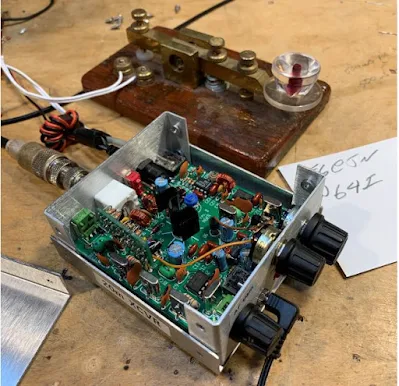Invest 94L moved arcoss the Mona Passage yesterday, lowering temperatures, bringing lots of rain and relatively high winds to the area. I happened to check on reception in the DR of WIDI 99.5 FM (near Mayaguez, Puerto Rico), and was surprised to find that the signal had weakened considerably. This morning, after the storm passed, signal levels were back to their normal full quieting. This would support the idea that tropospheric ducting is playing a big role in bringing this signal into the Dominican Republic. I had been surprised by the persistence of the signal -- for weeks it had been full quieting here. I thought that perhaps I was just receiving it directly, line-of-sight, without the benefit of tropo ducting. But Invest 94L has made me question this idea.
I asked Google Gemini AI about the persistence of tropospheric ducting on FM broadcast signals in the tropics. Here is what it said:
AI OverviewIn the tropics, tropospheric ducting is a frequent, persistent, and often strong phenomenon, especially over and around large bodies of water. Unlike mid-latitudes where ducting is a seasonal event, the meteorological conditions in the tropics are favorable year-round.
Why ducting is persistent in the tropicsHigh temperatures and humidity: Tropical climates are characterized by consistently high temperatures and abundant moisture. These conditions are the primary drivers of atmospheric ducting.
Temperature inversions: Stable high-pressure systems common in the tropics can create temperature inversions, where a layer of warm, moist air sits above cooler air. The sharp change in temperature and humidity with altitude creates the "duct" that traps and bends radio waves over long distances.
Dominance of water paths: Large tropical ocean regions are ideal for ducting. A common ducting phenomenon called the "evaporation duct" is ever-present over the sea surface due to a sharp humidity gradient and is particularly effective for trapping frequencies above 3 GHz. While the FM broadcast band (87.5–108 MHz) is at a lower frequency, coastal areas and islands frequently experience ducting over sea paths.
Atmospheric stability: The general stability of high-pressure systems in the tropics allows ducting conditions to persist for many months at a time. This is observed in areas like the Caribbean and the Persian Gulf, where long-distance radio reception is a common occurrence.
Impact on the FM broadcast band (VHF Band II)Favorable frequencies: The FM broadcast band (VHF Band II) is particularly susceptible to tropospheric ducting. While ducting can occur across a range of frequencies, signals above 90 MHz generally propagate more favorably during ducting events than lower frequencies.
Signal interference: The most noticeable effect of this regular ducting is co-channel interference, where distant stations can override local ones. During an event, a listener may pick up two different stations on the same frequency, or experience temporary loss of reception from a nearby transmitter.
Extended reception: For radio hobbyists, this high frequency of ducting means that signals from FM stations hundreds or even thousands of kilometers away can be received clearly.
Diurnal cycle: Ducting events in the tropics often peak during the evening and overnight hours when surface cooling creates a stable nocturnal boundary layer. Conditions may "burn off" after sunrise, but ducting is common throughout the day during periods of stable weather.
In summary, the specific meteorological and geographical conditions found in tropical regions—consistent heat, humidity, and the presence of large bodies of water—make persistent tropospheric ducting on the FM broadcast band not just possible, but highly probable throughout the year.




























